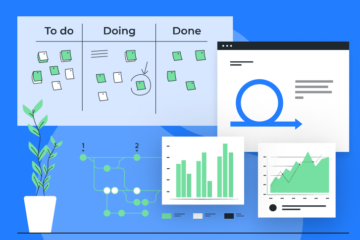The Agile Development Processes We Use to Run Our Remote Team

Using an agile approach for development processes has shown to increase time-to-market by 37% and give 16% higher efficiency. You can see how, as an approach, agile development surpasses more traditional software development methods.
Today, agile development processes are facilitating the client and developer very resourcefully, increasing in popularity over other software development life cycle models.
In this article, you will learn what agile development processes are and how they differ from more traditional development methods. You are then given a unique insight into how agile development is used to run a remote team.
With that said, let’s jump straight to it!
Moving away from traditional software development approaches to be agile
A software development process is a series of tasks and activities that, when executed in the correct order, assist the development of a software product.
Coupling software development processes with agile methodology gives agile software development processes.
Before a more agile approach came into the mainstream, many of the pre-1990’s software developers followed the Waterfall Model for software development.
A waterfall model represents a linear and sequential approach to software development, carrying out the following steps:
Requirements: Gather, analyze and document,
Design: Producing software architecture,
Code: Development, proving, and integration of software,.
Testing: Systematic discovery and debugging of defects,
Operations: Installation, support, and maintenance of complete systems.
On using the waterfall model, each sequential task acts as a sort of gateway. That is, completion of one step is key for moving forward.
So why did agile methodology come about? What benefits does agility give over this traditional waterfall method?
For many developers, the waterfall method proved to be too rigid and linear. In contrast, agile software development processes are flexible, with a focus on continuous improvement and speed.
Agile software development and the benefits of using this approach
Agile software development describes software development processes that are based on iterative development, where requirements and solutions evolve through collaboration between self-organized and cross-functional teams.
Agile development is a powerful tool, giving process and efficiency benefits to the software development team and an organization as a whole.
Listed below are 8 primary benefits that come with this novel, agile methodology:
- Improves quality - Having an iterative approach helps to keep pace with dynamic development environments.
- Increases productivity - With efficiency increases and short iterations for rapid change.
- Is value-driven - The agile methodology focuses rigorously on delivering business value early and continuously. From week to week, iteration to iteration, a team will track how many running, tested features are delivering results.
- Engages stakeholders - By engaging different stakeholders in every step of a project, agile processes provide multiple opportunities for stakeholder and team engagement - both before, after, and during the sprint.
- Increases transparency - Agile methods are used to reduce software development risk by increasing transparency. Increased transparency reduces the risk of producing work that has poor quality and low value.
- Early and predictable delivery - New features are delivered regularly and predictably with sprints lasting 1-4 weeks.
- Allows for change - The client is the most important asset during software development. The agile approach allows for change requests at any stage in the project. Be sure to utilize a cost-time estimation technique to balance change requests with business capacity (cost and time).
- Promotes Robotic Process Automation (RPA) - Applying agile methodology can deliver RPA at scale, removing repetitive, time-consuming tasks from the process.
It is because of these benefits that an agile approach is one that we at Process Street use to run our remote team. In the next section of this article, you will learn how we do this.
How Process Street uses agile development processes to run our remote team
The first step to agile development is to document processes. When it comes to becoming agile, running in the dark is not an option.
You need to know exactly what tasks a software team is undertaking and where their time is going.
At Process Street we have documented processes like our regular Daily Standup Meeting, Sprint Planning, and Sprint Retrospective.
We also run Quality Assurance (QA) processes such as an SSL Certificate Renewal process and Weekly WordPress Maintenance.
And finally, we have documented training processes such as our Developer Onboarding, and Pull Request Merge Procedure.
These development processes are iterative and provide space for team-wide collaboration internally within the software development team and with other cross-functional teams.
Agile principles like dedicated teams, upfront design, maintaining a backlog, using agile tools, sprint planning, and retrospectives.
At Process Street, our agile process runs in 1-week long sprints for our dev team, and 4-week long sprints for non-tech teams.
Running agile development processes for a remote team, step #1
We begin by following the sprint planning process. During this time we collate issues and estimate the time it will take to track and solve these issues.
Our Daily Standup Meeting Process provides a means for the whole team to check in on the sprint’s progress and take care of any problems.
Automation is then incorporated into the sprint planning process, setting up an integration that notifies the relevant team members of the upcoming meetings for collaboration.
Team members prepare for the meeting, adding their work in progress issues to the relevant QA process. Our team leader runs through everyone’s issues one-by-one in a screen share where the whole team can add their input.
Our Daily Stand Up Meeting checklist has gone through many iterations since its creation, making improvements to the process. For instance, a recent addition to the checklist was the inclusion of a task to check that no issue is left orphaned.
Running agile development processes for a remote team, step #2
The next step is the sprint turnover. At this point, the last sprint is coming to the end, and the upcoming sprint is planned. The sprint turnover is documented using our Sprint Turnover Checklist. Documentation makes sure no issues are overlooked.
Team progress is tracked, with the continuation of daily standup meetings assisting members to attain their sprint goals.
Sprints are planned to balance meeting overall targets and goals, and giving an achievable amount of work. We weigh each team member's tasks proportionately to the time and effort needed to complete that task.
Tasks could include the handling of pull requests from QA. Pull requests can be risky, and so a lot of effort is needed to make sure that they are handled with care. As such, we have a process for every single pull request, with these processes emphasizing steps for thorough testing.
It is also important to keep on top of regular maintenance work, and so processes such as our Weekly WordPress Maintenance checklist are run.
Running agile development processes for a remote team, step #3
The sprint retrospective is a vital process for continuously improving the way your team runs their agile processes. During the sprint retrospective the following points are discussed in your team:
- What went well during the sprint cycle?
- What went wrong during the sprint cycle?
- What could we do differently to improve?
All this information is summarized into our team chat application, Slack.
Pulling the information and summarizing it into our chat application is an automated process. Based on this example and the example of automation given above, you can see how reducing data entry and increasing collaboration is promoted in an agile approach which incorporates automation potential.
We’re basically automating a huge chunk of employee communication - and it makes everyone’s lives easier.
How do you use agile development processes to run your team?
An agile approach gives means for dealing with and succeeding in a turbulent environment by remaining flexible. In this article, we focussed on agility in software development, but the principles can be extended outside of software development.
In essence, agile is a mindset, revolving around the question, “How might we structure and operate our organization in a way that allows us to create and respond to change and deal with uncertainty”?
Any agile approach is never truly agile until the organization changes its fundamental structure and approach. The rewards from doing so are however substantial.
Author: Jane Courtnell

Bio: I am a writer at Process Street. While earning my degree in Biology I specialized in Environmental Science at Imperial College London. I developed an enthusiasm for writing to communicate environmental issues. I continued my studies at Imperial College's Business School, and with this, I began looking at sustainability in a business sense. When I am not writing, I enjoy being in the mountains, running and rock climbing.
Sources:
https://dzone.com/articles/benefits-of-agile-project-management
https://www.browserstack.com/guide/learn-software-development-process
https://www.tutorialspoint.com/sdlc/sdlc_waterfall_model.htm
https://www.americanexpress.com/en-us/business/trends-and-insights/articles/agile-business-strategy-making-room-for-standard-operating-procedures/
https://thedigitalprojectmanager.com/workflow-management-software/
https://hackernoon.com/top-32-jira-alternatives-for-agile-project-management-teams-bv173ym3
https://www.chanty.com/blog/effective-employee-communication/





No comments